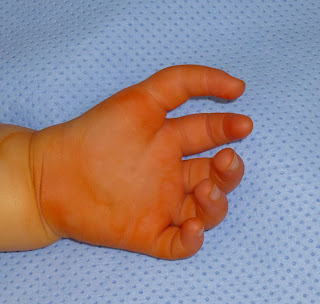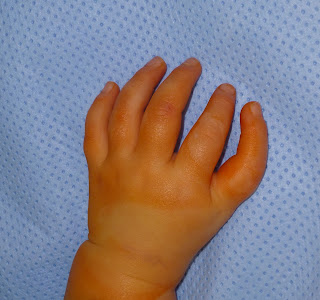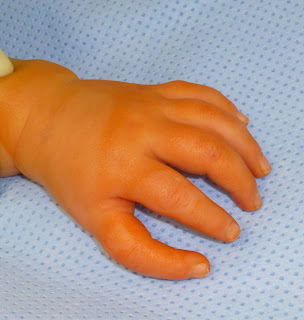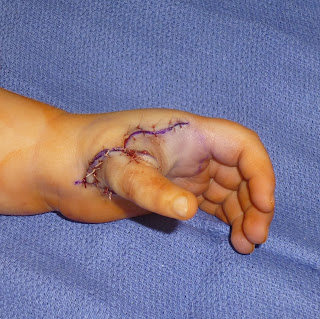The 5- finger hand is a rare anomaly in which there is no thumb, but rather 5 digits in the same plane (i.e., in a row) without a thumb. That means each digit has three bones (whereas the thumb normally has two bones). This is important because the normal thumb function is not present because there is no digit where the thumb normally rests. This means that manipulation of small objects is difficult because the fingers must manipulate the objects, on the side of each digit (scissoring). Without a thumb the fleshy pulp cannot manipulate the objects. Also, it is difficult to grasp larger objects because the biggest object is grasped between the fingers (which does have as much space as the thumb/ fingers). Some children have a “thumb in the plane of the fingers” anomaly which is similar. However, the difference is that these kids usually have less than 5 digits and have an associated medical problem. We have shared our experience with this anomaly in the medical literature. http://www.ncbi.nlm.nih.gov/pubmed/19897326
We consider surgical reconstruction of the 5- finger hand to improve function (and also appearance). The digit on the thumb side of the hand is shortened and rotated to create the function of a thumb. Sometime an entire bone can be removed or other times the metacarpal bone in the hand is simply shortened. Here is an example of a 5- finger hand.
 |
| 5- finger hand |
 |
| Another view of 5- finger hand prior to reconstruction |
 |
| Final view of 5- finger hand |
There are a few reports of treatment of the 5- finger hand, most recommending pollicization. http://www.ncbi.nlm.nih.gov/pubmed/21093346 and http://www.ncbi.nlm.nih.gov/pubmed/5506242
While the considerations are complex, pollicization is one good option for this anomaly. Here is our pollicization for this patient.
 |
| Pollicization in 5- finger hand |
 |
| Another view of pollicization in 5- finger hand. Note, the new thumb is slightly long (based on discussion with family and possible additional surgery later). |





At what age do you recommend pollicization?
Julie and Gabriel,
Thank you for the question. While there is no 'right' age, we typically operate at 18-24 months. Surgery at an earlier age can be done but structures are smaller.
Thank you. And how is the 5-finger hand different from a Triphalangeal thumb?
Great question and I disappointed that I have not made this more clear. Every 5- finger hand has a triphalangeal thumb but not every triphalangeal thumb is a 5- fingered hand. My definition of a 5- finger hand is a hand with 5 digits, each with three phalanges and each in the same plane (ie, no rotation triphalangeal thumb). In contrast, a triphalangeal thumb may be in the normal position of the thumb. Finally, to perhaps confuse matters more, there is the thumb in the plane of the hand. This a normal thumb (ie, 2 phalanges) but aligned with the fingers like the 5- finger hand. Clear as mud, right?
I just had a patient for a nephrostomy who had two five finger hands. In talking with this patient, he stated that he has seen thirty or forty individuals picking produce in the fields with him in California, who have the same congenital anamoly (in people from his area of Mexico.)
Thank you, fascinating. This certain can run in families and ethnic or cultural groups.
I was born with 2 5 fingered hands and extra sets of bones in my big toes. I’m 70 years old and it was not hereditary. When I was going thru surgeries which started 68 or 69 years ago, it was all experimental. My hands have never affected the use of them. I have always been able to do whatever I’ve needed to do. About the only thing I haven’t been able to do is snap my fingers but that’s ok.
The reason I am writing this is to give people courage and let them know that they can live a very normal life.
Laura- thank you for sharing you experience.
My new born daughter has two five finger hands. Here most doctors in China had recommended us to do surgeries at 6-12 months. I was wondering if this is too early?
Jerry,
Congratulations on the birth of your daughter. There is no “right” or “wrong” time. I do prefer to wait a bit longer but some surgeons may prefer younger. To me, 6 months seems quite early. The main consideration is assuring that your surgeon has experience with this condition- the more children treated, the better. Despite its rarity, there should be experience.
Dr. Goldfarb,
Thanks for replying! I just wanted to follow up with a few questions:
1. Typically after the pollicization surgery, what is the overall functionality of this thumb like compared to a normal thumb? I know it may vary due to different factors but just want to see from your past experience. I’ve got doctors telling me it can function 80-90% of a normal thumb.
2. Me and my wife doesn’t have any hands deformity in our family history, so was wondering if this is just a random gene mutation caused by external factors? If so, will my daughter’s kids in the future inherit from her? Also, I’m worried if there are any other diseases associated with the five finger hand? So far all other parts of her body (organs, feet,etc.) are healthy but I just want to see if a chromosome check is necessary to screen out any other potential diseases? I’ve got one doctor suggested me to do so but others all thought it’s kinda unnecessary.
Forgive me for asking so many detailed questions, but I know in terms of orthopedics, doctors in the U.S for sure are world-class. If you have an email address that I can reach out to, that’d be awesome. Understand if you aren’t able to, still appreciate your generous help here.
Jerry,
You can certainly email at congenitalhand@wustl.edu.
In response to your questions.
1) The thumb typically moves well (depends on how ‘normal’ the index finger is before surgery) but strength is decreased. Can be highly functional although difficult to quantify.
2) While this can be genetic, sometimes it is more random. We do typically test assess for associated conditions including issues with the heart, kidney, spine. We often genetically test as well as it can be helpful informationally.
I have 2 triphalangeal thumbs. So does my dad, my uncle, my grandpa and my grandfather’s sister. Having triphalangeal thumbs I think gives me more of an advantage than disadvantages.
Arielle,
Thank you for sharing. Your family’s experience is common as triphalangeal thumbs are strongly genetic. Some of the best studies have come from Rotterdam in The Netherlands with a large number of affected families.
I am glad you feel that the triphalangeal thumbs offer advantages. I typically hear more regarding challenges with the extra bone.